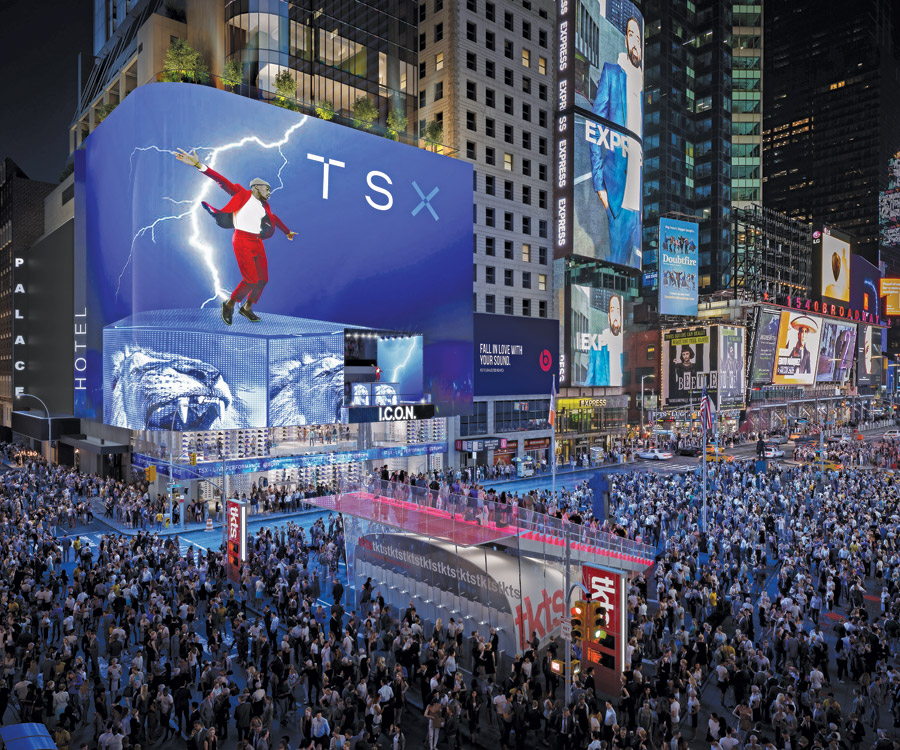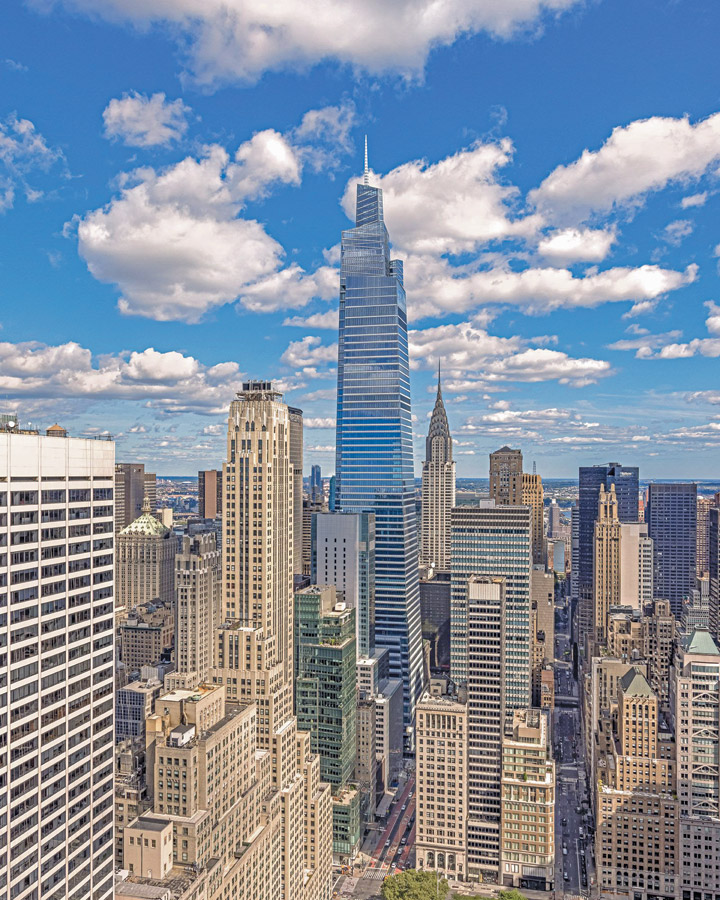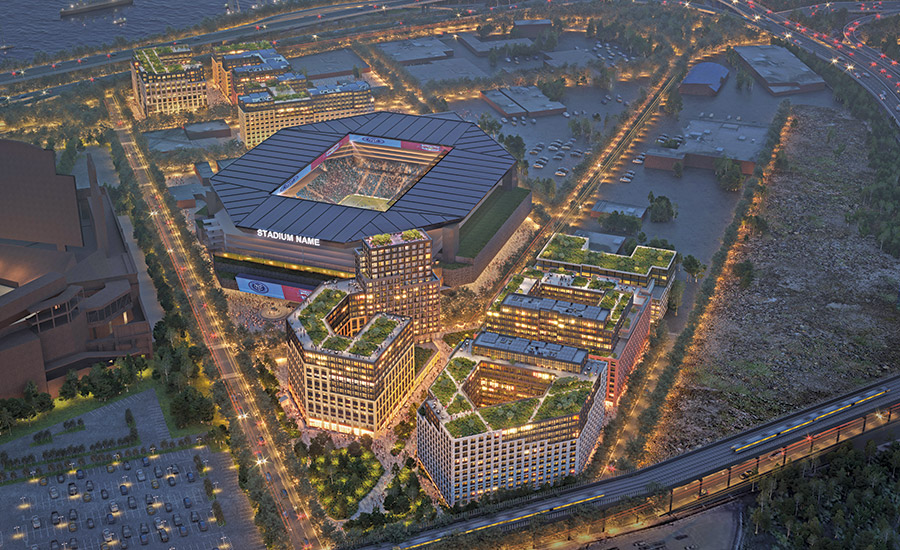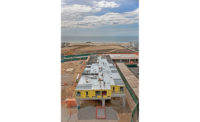When first joining engineering and consulting firm Langan almost 40 years ago, George Leventis had a sense that the company was dynamic, entrepreneurial and young—with leadership that valued the people it hired. That hunch was right and that culture persisted. “The big question was, as we were growing, how do we mentor the next generations to keep providing these high level services,” says Leventis, lead managing principal of Langan's New York office. “It’s not easy. It’s a lot of work. You need to hire intelligent people with entrepreneurial spirit and mentor them.”
Founded over 50 years ago, Langan has grown from a roughly 35-person outfit in the 1980s to one with more than 1,600 employees across 43 U.S. offices, along with an international arm. About 40% of staff are located in the New York region, with its two largest offices in Parsippany, N.J.—home of the company’s headquarters—and New York City.
Regional roots have been a boon in Langan’s efforts to secure work, including landmark projects such as One Vanderbilt and Hudson Yards in Manhattan, parks and other green spaces throughout New York City and providing amenities to schools and universities on both sides of the Hudson River.
“Langan’s New York practice is a powerhouse,” says David Gockel, Langan president and CEO. He says the firm “provides multiple environmental and engineering services on critical infrastructure needs of the city ranging from programmatic expansion at airports to brownfield redevelopment consulting that delivers much needed affordable housing to renewable energy initiatives that provide resilience to our grid.”
Langan’s core specialties of environmental, geotechnical and civil and land development work are integrated at a high level throughout the company, Leventis says. “When you have complex sites, these three disciplines affect each other,” he says. “We make a big deal about exposing our people to all three.”
Looking at Langan Projects
Recent and underway projects in New York and New Jersey include massive efforts with multiple components:
The long polluted 1.8-mile-long Gowanus Canal is undergoing a revitalization under New York state’s Brownfield Cleanup Program. Langan has guided several clients through the program and has worked on nearly 30 project sites surrounding the Brooklyn waterway. “They are a mix of heavy-duty environmental, land development, geotechnical and waterfront work,” says George Leventis, managing principal.
At John F. Kennedy International Airport in Queens, N.Y., Terminals One and Six design-build projects both are under construction, according to Alan Poeppel, managing principal. The first part of the $9.5-billion Terminal One will open in 2026, with final completion set for 2030. Terminal Six, a $4.2-billion effort, will partially open in 2026 and wrap up work in 2028.
A multidisciplinary redevelopment effort recently went into M Station in Morristown, N.J., which transformed a shopping center into an office and retail development anchored by Deloitte that links downtown to the city’s existing train station. Work also included a 1,000-space parking garage and a public plaza.
Projects Aplenty
Langan’s services span industries, making for an expansive project portfolio. In 2019, the firm was heavily into e-commerce throughout New York state and in the metropolitan area, says Alan Poeppel, managing principal. “We were early into that market, and it just exploded from 2020 to 2022. One year builds off the next,” he says.
While that work has started to cool off, strength in e-commerce bolstered the firm through 2021 and 2022. Ranked fifth on the ENR New York Top Design Firms list for the second year, Langan’s regional revenue across New York and New Jersey totaled $225 million in 2022—the company’s 12th consecutive year of record growth and a nearly 20% increase over 2021. It also ranks at No. 46 on ENR’s 2023 Top 500 Design Firms list, with $463 million in national revenue.
“We were early into [the e-commerce]market, and it just exploded from 2020 to 2022.”
—Alan Poeppel, Managing Principal, Langan
Another factor in that strong performance was affordable housing and brownfield redevelopment work done under two programs, one being New York state’s Brownfield Cleanup Program. The other was New York City’s now lapsed 421A Tax Abatement program, which provided a tax credit to real-estate developers for building new multifamily and affordable housing in New York City. The program had a vesting last year, translating into a charge “for developers to get their projects vested or have a permanent foundation element in the ground by June 15, 2022,” Poeppel says. “It probably took 24 to 36 months worth of development and packed it into about 18 months, really fast-forwarding some projects at least to get them to that point.”
Langan has also been doing a lot of waterfront and resilience work, adds Mimi Raygorodetsky, principal and an environmental practice leader in Langan’s New York City and Denver offices. “New York City has 520 miles of shoreline, and for decades it was generally used for industrial work and manufacturing,” she says. “Integrated multidisciplinary work at Langan is helping transform those waterfronts.” One such project is Greenpoint Landing in Brooklyn, a 22-acre waterfront development that Raygorodetsky has been working on for decades. The first project broke ground in 2012 and four affordable housing buildings have been built to date, with eyes on a fifth. It will also create about six acres of public open space at the waterfront.
Such efforts are underway overseas as well. Langan is acting as the overall technical adviser on The Ellinikon waterfront development in Athens, which was previously the site of the old Athens International Airport and covered a total area of 6.2 million sq meters. Langan continues to adapt to new opportunities, having pivoted into renewable energy over the last several years. Work includes solar projects across New York state as well as grid resilience and upgrades, with projects to bring power from upstate and offshore turbines into the city for distribution.

Langan’s geotechnical team helped safely lift the landmark Palace Theatre in Manhattan 30 ft to a new high-rise location and excavate beneath without disturbing the historic building.
Rendering by Era-Co
Diversity and Wellness
While pandemic urgencies have mostly subsided since Langan shifted within two days to get employees switched to remote work, the firm continues its flexible model. Staff can work from anywhere, anytime, as long as work is completed. “It gives them flexibility but is also frankly a good recruiting tool,” Poeppel says. “It also allows us to employ people who are really talented but not even close to a physical Langan office who can still contribute in a very meaningful way being remote.”
“We provide this sense of community, opportunities to learn and grow and to develop into the leaders that we can be.”
—Michele O’Connor, Senior Principal and co-leader of Langan’s New York City-Based Civil Engineering practice
Employee resource groups have played a vital role in helping employees find a sense of belonging, even when working remotely. Michele O’Connor, senior principal and co-leader of the New York City-based civil engineering group, realized nearly eight years ago that she was a woman leader in a position to make a difference. So she helped found Women@Langan, an employee resource group that would become the foundation for a diversity, equity and inclusion shift. “We provide this sense of community, opportunities to learn and grow and to develop into the leaders we can be,” O’Connor says. “It paved the way for all the other initiatives that we’ve launched in the last two years.”
Women@Langan’s creation has led to nine other ERGs so far, including Black Professionals@Langan, Queer@Langan, Asians@Langan and LatinX@Langan. “The feedback from employees who have created these groups has been moving to me,” says Raygorodetsky. “They’ll say things like, it was so fulfilling to be part of starting @Langan. It means so much to me to be able to bring my whole self to work.”
Further efforts to ensure well-being coalesced into Langan’s wellness initiative, which focuses on flexibility, recognition and communication. It includes actions such as encouraging managers not to email during off hours and making sure employees are allowed flexibility in determining when and where they work. “It’s helped with retention, and it’s created a really positive and beneficial work environment,” says Raygorodetsky.

Langan contributed to the sustainable design of One Vanderbilt, a 1,401-ft office tower located next to Grand Central Station in Manhattan.
Photo by Max Touhey, courtesy of SL Green
Forging Bonds
Langan fosters an entrepreneurial culture, encouraging employees to innovate, adapt and collaborate. Building multidisciplinary teams is a company strength, notes O’Connor. “It provides efficiencies for clients and clear communication,” she says.
Langan’s teams focus on not just delivering the project. Instead, there is pride in looking at a project much like a developer would. This ensures that the consulting team understands the client and its business and what is most important in creating a successful project. “The benefit is not just a well-designed and executed project, but one on which we understand schedule and budgets, so there’s economy there,” O’Connor says.
Employees at Langan are dedicated to creating lasting relationships with clients. More than 90% of its top 100 clients are repeat customers, Leventis says. “The word competitive doesn’t mean that you need to win work at lower fees. If you do good work and provide significant value to your clients, they’ll come back to you,” he says.
For more than 30 years, developer The Related Cos. has partnered with Langan on a range of projects. While much of that work is in New York, the relationship spans across the country. “Even before a project starts, Langan helps us a lot with feasibility studies and preconstruction site investigations,” says Emad Lotfalla, Related’s executive vice president of design and construction. The firm is “always a good resource to get information before starting any design or even buying a site.”
A recent combined effort is Clean Path NY, one of the largest energy projects in New York state, Lotfalla says. This $11-billion clean energy infrastructure effort includes more than 20 onshore wind and solar generation projects and a 175-mile underground transmission line. “Langan’s knowledge about New York is second to none,” Lotfalla says. Firm staffers “are problem-solvers and always work hand-in-hand with the client. That’s why we continue to use them in most of our projects here, especially the difficult ones,” he adds.
Langan has been doing civil and environmental work on the Willets Point, Queens, development for Related and helped lead it through brownfield cleanup. Both firms have worked on it for more than a decade. About 2,500 affordable homes, a 650-seat public school, soccer statium, hotel, retail and infrastructure are included in redevelopment of the 23-acre site.
Now getting underway is the Governors Island Climate Center, a $700-million climate research, education and jobs hub on Governors Island. The 400,000-sq-ft campus will house a consortium led by Stony Brook University. “We’ve been doing work on Governors Island for more than 15 years,” says Poeppel, with this being one of the largest to date.
Looking ahead to future projects, Langan will continue to focus on growth not just for bottom-line benefit, but also to provide the best platform for employee professional development, Leventis says.





Post a comment to this article
Report Abusive Comment